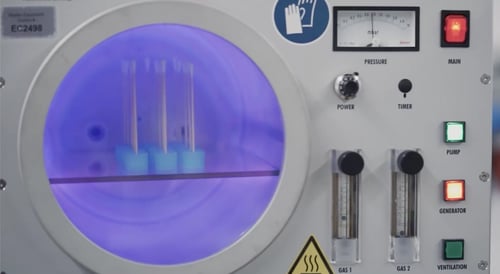
Paint wetting impairment substances – PWIS for short – cause clearly visible defects in the end product, since they prevent an even wetting of the surfaces to be coated.
Paint wetting impairment substances – PWIS for short – cause clearly visible defects in the end product, since they prevent an even wetting of the surfaces to be coated. Funnel-shaped impurities and craters appear in the paint layer. Such substances can be silicones, fluorinated (PTFE) substances, certain oils and greases.
The plasma process permanently dissolves all paint wetting impairment substances from the surface as well as from the elastomer itself.
Components made of a large variety of materials can be cleaned, such as PVC-U, PVC-C, PP, PE, ABS and PVDF as well as metal components.
After cleaning, the components undergo plasma treatment for up to one hour, depending on their degree of contamination. To confirm the success of the treatment and ensure the components are PWIS-free, a PWIS test is carried out after the plasma treatment. The test we use is in compliance with the Volkswagen Test Regulation PV 3.10.7 and is a rapid test for the detection of residual silicones.
All you need is a clean glass plate, acetone, a commercially available spray paint which obviously must be free of silicones. The colour white has proven to be particularly well suited for this test. For the test, the material is placed on the glass plate and rinsed with acetone. After venting of the acetone, the glass plate is sprayed crosswise with the spray paint. After drying of the paint, it is clearly visible whether there are silicone residues on the surface. In these spots, the surface is not wetted by the paint, and so-called crater formation is observed.
Using special processes, however, plasma treatment is also suitable for treating silicone materials. Even silicone rubber can be made PWIS-free.
Removing PWIS substances from component surfaces meant to be coated, innovative and environmentally compatible low-pressure plasma technology can solve a problem which is becoming more and more pressing. Plasma cleaning processes integrated in the production chain have for example the following benefits:
Diener electronic also offers this process as a surface treatment service. Several plasma systems as well as skilled and experienced staff are at your disposal. Thus, we can ensure optimum surface quality of your components and parts.
To learn more about etching, check out our eBook titled "Plasma Etching and Cleaning Strategy for Better Product Quality."
Plasma: +1 (248) 761 9253
Distribution: +1 (248) 549 8600
Fax: +1 (248) 549 3533
info@thierry-corp.com